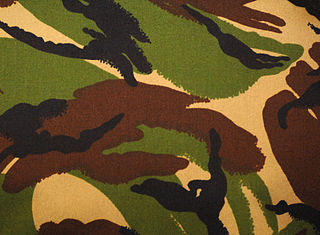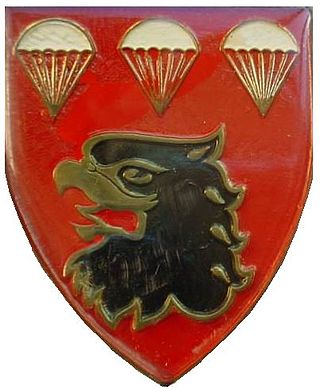
The Special Air Service (SAS) is a special forces unit of the British Army. It was founded as a regiment in 1941 by David Stirling, and in 1950 it was reconstituted as a corps. The unit specialises in a number of roles including counter-terrorism, hostage rescue, direct action and special reconnaissance. Much of the information about the SAS is highly classified, and the unit is not commented on by either the British government or the Ministry of Defence due to the secrecy and sensitivity of its operations.

The Army of the Republic of Vietnam composed the ground forces of the South Vietnamese military from its inception in 1955 to the Fall of Saigon on 30 April 1975. At the ARVN's peak, an estimated 1 in 9 citizens of South Vietnam were enlisted, composed of Regular Forces and the more voluntary Regional Forces and the Popular Force militias. It is estimated to have suffered 1,394,000 casualties during the Vietnam War.

The Special Air Service Regiment, officially abbreviated SASR though commonly known as the SAS, is a special forces unit of the Australian Army. Formed in 1957 as a company, it was modelled on the British SAS with which it shares the motto, "Who Dares Wins". Expanded to a regiment in August 1964, it is based at Campbell Barracks, in Swanbourne, a suburb of Perth, Western Australia, and is a direct command unit of the Special Operations Command.

The 1st Special Service Force was an elite joint American–Canadian commando unit in World War II, formed by Lieutenant Colonel Robert T. Frederick of the Operations Division of the U.S. General Staff. During the Italian campaign of World War II, it was commanded by Frederick and attached to the United States Fifth Army. In August 1944, the Force was attached to 1st Airborne Task Force for the campaign in southern France.

The 1st Commando Regiment is an Australian Army Reserve special forces unit, part of Special Operations Command with an integrated structure of regular (full-time) soldiers and reserve (part-time) soldiers, which together with the full-time Australian Army 2nd Commando Regiment, provides the commando capability to Special Operations Command. 1st and 2nd Commando companies were raised in 1955 and were combined with 126 Signal Squadron (SF) in 1981 to form the 1st Cdo Regt. The regiment's two commando companies are the oldest sub-units within Special Operations Command. In 2008, the regiment deployed to Afghanistan to become the first Australian Army Reserve force element on combat operations since World War II. The regiment is the Command's capability lead for special warfare.

The United States Army Rangers are elite U.S. Army personnel who have served in any unit which has held the official designation of "Ranger". The term is commonly used to include graduates of the Ranger School, even if they have never served in a "Ranger" unit; the vast majority of Ranger school graduates never serve in Ranger units and are considered "Ranger qualified".

The 160th Special Operations Aviation Regiment (Airborne), abbreviated as 160th SOAR(A), is a special operations force of the United States Army that provides helicopter aviation support for special operations forces. Its missions have included attack, assault, and reconnaissance, and these missions are usually conducted at night, at high speeds, low altitudes, and on short notice.

The Army Reserve (AR) is the reserve land component of the Irish Defence Forces. It is the second line reserve of the Irish Army. The Army Reserve involves active military service on a part-time basis, and is one of two elements of the Reserve Defence Forces, the other element being the Naval Service Reserve (NSR).

The South African Special Forces Brigade, colloquially known as the Recces, is South Africa's principal Tier 1 special operations forces, specialising in various types of operations, including counter-insurgency, long-range-reconnaissance, unconventional-warfare, and hostage rescue. The brigade operates with two active-duty groups, with 4 Special Forces Regiment focusing on maritime operations, and 5 Special Forces Regiment focusing on land and airborne operations. Only about 8% of recruits who undergo South African special forces training pass the course.

Disruptive Pattern Material (DPM) is the commonly used name of a camouflage pattern used by the British Armed Forces as well as many other armed forces worldwide, particularly in former British colonies.

The Special Forces Support Group (SFSG) is a special forces unit of the British Armed Forces. The SFSG was formed officially on 3 April 2006 to provide support to the Special Air Service, the Special Boat Service and the Special Reconnaissance Regiment on operations. It is a tri-service unit, composed of the 1st Battalion, Parachute Regiment,, a company of Royal Marine Commandos, and a flight (platoon) from the Royal Air Force Regiment.

The Rhodesian Security Forces were the military forces of the Rhodesian government. The Rhodesian Security Forces consisted of a ground force, the Rhodesian Air Force, the British South Africa Police, and various personnel affiliated to the Rhodesian Ministry of Internal Affairs. Despite the impact of economic and diplomatic sanctions, Rhodesia was able to develop and maintain a potent and professional military capability.

The ERDL pattern, also known as the Leaf pattern, is a camouflage pattern developed by the United States Army at its Engineer Research & Development Laboratories (ERDL) in 1948. It was not used until the Vietnam War, when it was issued to elite reconnaissance and special operations units beginning early 1967.

The 3rd Battalion, Parachute Regiment, is a battalion sized formation of the British Army's Parachute Regiment and is a subordinate unit within 16 Air Assault Brigade.

Special forces or special operations forces (SOF) are military units trained to conduct special operations. NATO has defined special operations as "military activities conducted by specially designated, organized, selected, trained and equipped forces using unconventional techniques and modes of employment".

7 Medical Battalion Group is the specialist Airborne Medical Unit of the South African Military Health Service. The Battalion's main task is to render medical support to the South African Airborne and Special Forces. The unit falls under the command of the Mobile Military Health Formation.

The Special Forces Regiment (Airborne) is a Special Operations Forces unit of the Philippine Army. The unit is based on and continually trains with its American counterpart, the U.S. Army Special Forces (Green Berets).

Strichtarn was a military camouflage pattern developed in East Germany and used from 1965 to 1990. The pattern was also used by several other militaries and non-state forces, notably in Africa.

The Bagaka Regiment is a reserve airborne infantry regiment of the South African Army.

3 Parachute Battalion is a Citizen Force paratroop unit of the South African Army. It was established in July 1977 within the formation of the Parachute Battalion. Later it was a battalion within 44 Parachute Brigade. As a reserve unit, it has a status roughly equivalent to that of a British Army Reserve or United States Army National Guard unit.



















